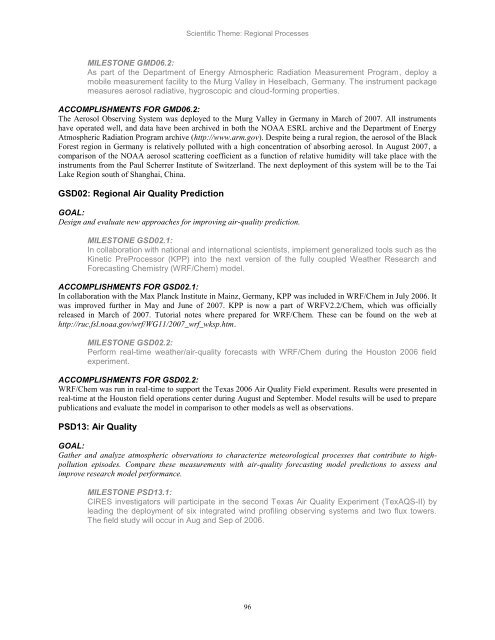Scientific Theme: Advanced Modeling and Observing Systems
Scientific Theme: Advanced Modeling and Observing Systems
Scientific Theme: Advanced Modeling and Observing Systems
Create successful ePaper yourself
Turn your PDF publications into a flip-book with our unique Google optimized e-Paper software.
<strong>Scientific</strong> <strong>Theme</strong>: Regional Processes<br />
MILESTONE GMD06.2:<br />
As part of the Department of Energy Atmospheric Radiation Measurement Program, deploy a<br />
mobile measurement facility to the Murg Valley in Heselbach, Germany. The instrument package<br />
measures aerosol radiative, hygroscopic <strong>and</strong> cloud-forming properties.<br />
ACCOMPLISHMENTS FOR GMD06.2:<br />
The Aerosol <strong>Observing</strong> System was deployed to the Murg Valley in Germany in March of 2007. All instruments<br />
have operated well, <strong>and</strong> data have been archived in both the NOAA ESRL archive <strong>and</strong> the Department of Energy<br />
Atmospheric Radiation Program archive (http://www.arm.gov). Despite being a rural region, the aerosol of the Black<br />
Forest region in Germany is relatively polluted with a high concentration of absorbing aerosol. In August 2007, a<br />
comparison of the NOAA aerosol scattering coefficient as a function of relative humidity will take place with the<br />
instruments from the Paul Scherrer Institute of Switzerl<strong>and</strong>. The next deployment of this system will be to the Tai<br />
Lake Region south of Shanghai, China.<br />
GSD02: Regional Air Quality Prediction<br />
GOAL:<br />
Design <strong>and</strong> evaluate new approaches for improving air-quality prediction.<br />
MILESTONE GSD02.1:<br />
In collaboration with national <strong>and</strong> international scientists, implement generalized tools such as the<br />
Kinetic PreProcessor (KPP) into the next version of the fully coupled Weather Research <strong>and</strong><br />
Forecasting Chemistry (WRF/Chem) model.<br />
ACCOMPLISHMENTS FOR GSD02.1:<br />
In collaboration with the Max Planck Institute in Mainz, Germany, KPP was included in WRF/Chem in July 2006. It<br />
was improved further in May <strong>and</strong> June of 2007. KPP is now a part of WRFV2.2/Chem, which was officially<br />
released in March of 2007. Tutorial notes where prepared for WRF/Chem. These can be found on the web at<br />
http://ruc.fsl.noaa.gov/wrf/WG11/2007_wrf_wksp.htm.<br />
MILESTONE GSD02.2:<br />
Perform real-time weather/air-quality forecasts with WRF/Chem during the Houston 2006 field<br />
experiment.<br />
ACCOMPLISHMENTS FOR GSD02.2:<br />
WRF/Chem was run in real-time to support the Texas 2006 Air Quality Field experiment. Results were presented in<br />
real-time at the Houston field operations center during August <strong>and</strong> September. Model results will be used to prepare<br />
publications <strong>and</strong> evaluate the model in comparison to other models as well as observations.<br />
PSD13: Air Quality<br />
GOAL:<br />
Gather <strong>and</strong> analyze atmospheric observations to characterize meteorological processes that contribute to highpollution<br />
episodes. Compare these measurements with air-quality forecasting model predictions to assess <strong>and</strong><br />
improve research model performance.<br />
MILESTONE PSD13.1:<br />
CIRES investigators will participate in the second Texas Air Quality Experiment (TexAQS-II) by<br />
leading the deployment of six integrated wind profiling observing systems <strong>and</strong> two flux towers.<br />
The field study will occur in Aug <strong>and</strong> Sep of 2006.<br />
96
















